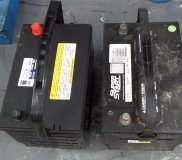No damage was done. If you were able to do damage by what you did with the ignition switch, that would affect a lot of people. To say that a different way, there would have to be a warning label somewhere telling you to not do that, along with the hundreds of other similar things you could do.
When you turn the ignition switch to the "run" position, the Engine Computer runs the fuel pump for one to two seconds. You can usually hear the hum in the back. Fuel pressure should hold for days or weeks, but they do that to insure fuel pressure is up high enough for the engine to start and run, in case it did happen to bleed down. After that, the fuel pump only runs when the engine is rotating, (cranking or running). That's a safety feature in case a fuel line gets ruptured in a crash. If the pump were to continue running, it would dump raw gas onto the ground where it would be a serious fire hazard. Instead, with the broken fuel line, there can't be any pressure in it. With no pressure, no gas will spray from the injectors, the engine can't run, and by two sensors, the computer will know the engine isn't rotating, so it will turn the fuel pump off.
The fuel pump actually moves a pretty large volume of gas, as in a gallon or more per minute. Almost all of that gas goes through the fuel pressure regulator, then right back into the tank. When the engine is running, a very small percentage of that gas is tapped off to go through the injectors, into the engine, to be burned.
To answer your second question, when you turn the ignition switch on but the engine is not running or cranking, if it is warm, or if outside air temperature is reasonably warm, no gas sprays from the injectors. If the engine and / or air temperature is cold, a small amount sprays for a priming squirt to make the engine start faster, with less cranking. The amount of gas sprayed depends on temperature, but it's still very small. It would probably take a dozen switch cycles to fill a teaspoon. You can't actually do that however. The computer will know it has just injected a priming pulse the first time you turned the ignition switch on, so it won't do it again for any subsequent events.
As a point of interest, Chrysler made reading diagnostic fault codes much easier than any other manufacturer. It is done by cycling the ignition switch from "off" to "run" three times within five seconds, without cranking the engine. Leave it in "run", then watch the fault code numbers appear in the odometer display. On most car models, if you think you may have misread or missed one of the code numbers, you just turn the ignition switch off, then right back on again, and the codes will repeat. As for those priming pulses, if fuel sprayed from the injectors each time you turned the switch on, that excessive raw fuel would wash down the cylinder walls as well as flood the engine. The engineers designed the system to not do that.
At most, by cycling the ignition switch to "run" one time, enough gas sprayed from the injectors to make your fingers wet and stinky.
SPONSORED LINKS
Thursday, September 5th, 2019 AT 6:06 PM



